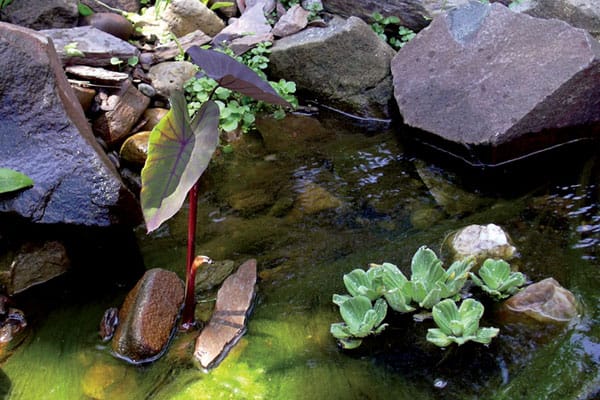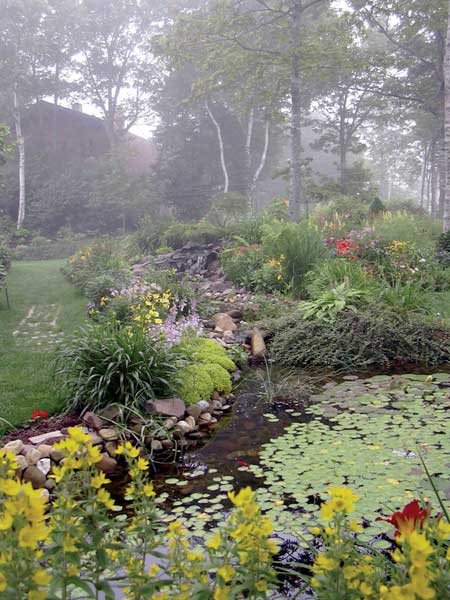Embracing the gentle art of the water garden.
One of the reasons we have a pond on our rural Nova Scotian property is to celebrate our area's wild flora and fauna. Ours is a naturally wet area that we dug out late one fall to increase its depth and develop some banking. It's long since repaid that expense by giving us an endless supply of sights and sounds. In fact it's become a real haven for all sorts of creatures-warm and cold-blooded, winged and finned, invertebrate and vertebrate. Surrounded by native and naturalized plant species both on its margins and in its depths, it's not a Martha Stewartesque piece of perfect waterscaping, but it's a place where I spend a lot of time contemplating nature (and avoiding deadlines).
Not everyone has room on their property to have a water feature of this size, however. For those who long for the sounds and sights of a water garden, there's an easy solution:Build your own, using any of a number of kits and equipment available at many garden centres.
An acknowledged authority in water gardening in Nova Scotia is John Bueglas of Dubé Botanical Gardens in River John, NS. John and his partner Rollande Dubé began their water garden business ten years ago, when ponds and water features were first starting to become popular.
"We spend a lot of time asking and answering questions when people come to us wanting a pond," John says. This way, he can gently guide the clients into deciding what they're looking for. Some questions include: Do you want a formal water garden or a more informal feature? Are you interested in colour, sound, plants, fish? Do you want a waterfall? Are you prepared to do some maintenance work to keep a water feature looking its best?

As with any hardscaping project, determining the ideal location for your water feature is first and foremost. Some people want to have their pond near the house so they can watch it from indoors as well as out. Others find that they want to create a secluded nook where the sound of gently trickling water can help take away the cares of the daily grind. The type of plants you plan to have in and around your pond also play a role in determining a site; water lilies, for example, bloom best when they are in a site with full sun, while some marginal plants like primroses prefer to have at least partial shade. You don't want to situate your pond underneath trees where you'll be constantly cleaning detritus such as leaves and twigs from the water.
Once the client's needs are determined, John will often suggest a pond kit, which comes complete with all parts: pond liner, pump, etc. These do-it-yourself type kits are designed for homeowners to install themselves. However, John recommends hiring a reputable contractor to do the work if a client is unsure about the logistics of digging the pond, doing the wiring to run the pump, installing the lining, etc.
In urban areas, it's a good idea to check with municipal bylaws to see if you have to put any sort of fence around your water feature. There might also be covenant restrictions around placing a water feature, such as a "brook" with a waterfall or a fountain, to avoid bothering nearby neighbours who might be disturbed by the sound of flowing water.
When digging out an area for a pond, make sure to remove all rocks and roots from the hole, so that there's nothing to puncture the pond's liner. A hole in a liner is the most common cause of pond failure. If you have unexplained water loss from your pond, this is probably the reason. Many pond constructors add sand to the bottom of the hole for extra protection for the pond liner once it is in place, and to prevent punctures during the construction process.
The "pondless waterfall" is one of John's most popular kits. This remarkable unit gives you the sight and sound of cascading water without the pond. The waterfall kits are especially popular with people who have specific safety concerns, such as keeping young children out of their water feature. Others don't want to go to the expense and difficulty of digging an entire pond area, but still would like to enjoy the sound and motion of water cascading over a fall. The drawback to these features, however, is that you can't put water lilies or fish in them.
If you don't have a yard or are unwilling to go to the expense and labour of digging and installing a pond kit, don't despair. There are a variety of options to create small water features, from using a large washtub or an old bathtub to building a trough out of hypertufa or purchasing a large glazed planter to hold one or two pond plants. Usually all you will need is a watertight container and a suitable pump, whether for waterfall effects or simply to keep the water circulating and aerated.
Even something as simple as a plug-in tabletop water fountain on your deck or other sitting area is a quick and wonderful way to add the sounds of water to your yard. As an added bonus, you can bring the fountain in during the cold months. If yours is a family with cats, you may find that you have to top up the water in your fountain on a regular basis; we find that no matter how much water we provide for our feline herd, they find the trickle of water from the copper tabletop fountain irresistible.
Pond plants
 Plants not only add a decorative feature to a water garden; they also play very important roles in maintaining a healthy pond ecosystem, providing shelter and food for organisms in the pond, and combating the growth of algae by taking up excessive nutrients.
Plants not only add a decorative feature to a water garden; they also play very important roles in maintaining a healthy pond ecosystem, providing shelter and food for organisms in the pond, and combating the growth of algae by taking up excessive nutrients.
Don't think you only have to purchase plants designated as water garden species. Remember that the margins of your pond-depending on its size-are also welcoming habitat for many moisture-loving perennials, including hostas, Japanese and drumstick primroses, astilbes, Siberian and Japanese irises, lobelia, ferns and day lilies. There are shrubs that work well as marginal plants, including Canada holly, elderberry, shadbush, willows and cotoneasters, many of which produce fruit that attract birds and other wildlife to your water garden vista. Some annuals such as elephant ears (Colocasia), canna lilies and calla lilies (Zantedeschia) also work well as marginal performers.
Keep in mind that some lovely pond plants aren't winter hardy, such as water hyacinth (Eichhornia spp), water lettuce (Pistia stratiotes) and parrot feather (Myriophyllum proserpinacoides).
Water lilies (Nymphaea) The queen of water garden plants. Larger lilies are more suited to deepwater ponds, and all prefer an open, sunny spot in the pond rather than shade.
Pickerel weed (Pontederia cordata) Often seen growing along the edges of ponds and lakes in our region, and easily recognized by its spikes of purple-blue flowers in mid to late summer.
Arrowhead (Sagittaria sagittifolia) Hardy in our area, with glossy arrow-shaped leaves and white flowers.
Cattails (Typha angustifolia) A very attractive and distinctive plant, but can become very invasive in smaller gardens.
Marginal plants
Marsh marigold (Caltha palustris) Shiny heart-shaped foliage, and lovely golden-yellow flowers in early-mid spring.
Chameleon plant (Houttuynia cordata) Ground cover with orange-scented foliage variegated in shades of red, gold, green and cream. Can be invasive in some climates and soils.
Corkscrew rush (Juncus effusus 'Spiralis') This unique rush has curled stems and adds a uniquely informal accent to a water or bog garden.
Umbrella plant (Darmera peltata) This tough perennial grows to 4 feet tall, with huge, umbrella-like leaves. Round clusters of small rosy-white flowers appear first in spring, followed by the leaves.
Globeflower (Trollius species) Clump forming hardy perennial with gorgeous giant buttercup-like flowers in yellow, orange or cream.
A few fishy friends
What's a pond without a few fish in it?
The most common choices for water gardens are goldfish, those popular darlings, and koi, also known as ornamental carp. Goldfish are generally much smaller, although they can grow to 10-16 inches depending on the species and the size of your pond, and can live between 15-25 years.
Koi, prized for their colours and their dramatic markings, are more exuberant pond-dwellers than are their smaller cousins. They also grow much larger, usually to between 22-28 inches, and can live upwards of 50 years.
To keep your fishy friends healthy and thriving, start with good fish. Buy from a reputable business where the staff actually know about koi, goldfish and other pond-dwelling fish. The fish should be in tanks or ponds that are adequate for the size of the species; you don't want to buy a large koi, for example, to be crowded into a small tank for indoor goldfish. Select fish that are lively and alert looking (upright fins is a sign of good health) with clear skin. Missing scales, open sores, broken fins and scars or marks can indicate parasite or bacterial infections.
Buy quality food, which is often in pellet form, and which include flavouring to attract the fish to come quickly for feedings. Many pond owners enjoy having their water-dwelling pets come right to their fingers for feedings.
If you keep fish in your pond through the winter, you want to keep the ice open in at least one part of the pond for gas exchange. Many plants give off gases which can kill fish trapped below ice. The easiest option is a floating pond heater, which will keep a hole open in the ice, or a pond circulating pump which keeps water moving at the pond surface.
If you want to bring your pond fish indoors for the winter, make sure to have an aquarium air pump in the tank to provide aeration. Feed the fish sparingly, and remember to place a cover on the tank, especially if you have koi, which are jumpers and may jump too far...
